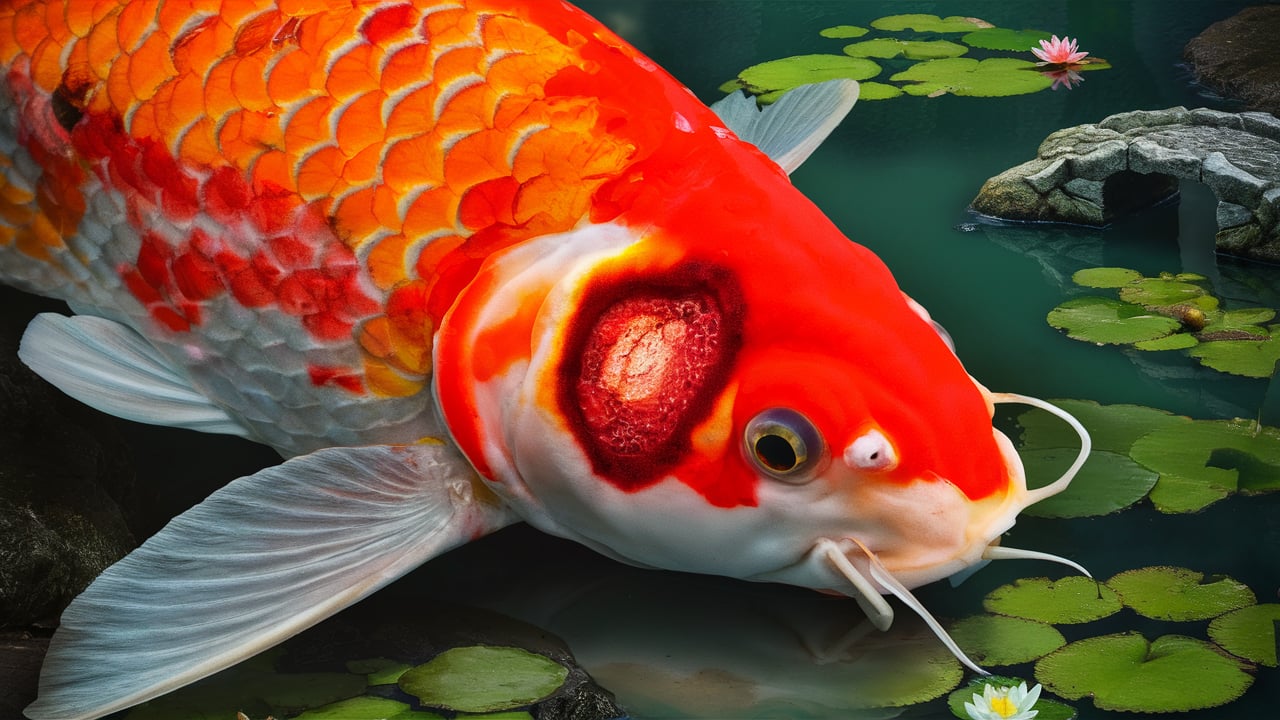Koi fish, with their vibrant colors and graceful movements, are a beloved addition to many water gardens. However, like any living creature, they are susceptible to health issues, including Koi Fish Ulcer. Koi Fish Beauty, dedicated to the well-being of these aquatic gems, provides comprehensive information on Koi Fish Ulcer, empowering you to understand, prevent, and manage this common health concern.
What is Koi Fish Ulcer?
Koi fish ulcer, also known as ulcerative dermatitis, is a skin condition characterized by open sores or lesions on the body of the fish. These ulcers can range in size and severity, from small, superficial wounds to deep, infected lesions that can severely impact the fish’s health.
The Causes of Koi Fish Ulcer: A Complex Web of Factors
Bacterial Infections: The Primary Culprit
Bacterial infections are often the primary cause of Koi fish ulcer. Several bacterial species, including Aeromonas, Pseudomonas, and Flavobacterium, are commonly implicated in the development of these ulcers. These bacteria can enter the fish’s body through wounds, abrasions, or even through the skin itself, especially if the fish’s immune system is weakened.
Parasites: Weakening the Fish’s Defenses
Certain parasites, such as Costia and Ichthyophthirius, can play a significant role in the development of Koi fish ulcer. These parasites can weaken the fish’s immune system, making them more susceptible to bacterial infections and ulcer formation. They can also cause damage to the skin, creating entry points for bacteria.
Poor Water Quality: A Stressful Environment
Poor water quality is a major contributing factor to Koi fish ulcer. High levels of ammonia, nitrite, or nitrates in the pond water can stress the fish and compromise their immune system, making them more vulnerable to infections and ulcer development. These toxins can also irritate the fish’s skin, making it more susceptible to damage.
Mechanical Injuries: Providing Entry Points for Bacteria
Scratches, abrasions, or injuries from sharp objects in the pond can provide entry points for bacteria and parasites, leading to ulcer formation. These injuries can also damage the fish’s skin, making it more susceptible to infection.
Nutritional Deficiencies: Weakening the Immune System
A lack of essential nutrients in the fish’s diet can weaken their immune system, making them more susceptible to ulcers. A balanced diet rich in vitamins, minerals, and protein is crucial for maintaining a strong immune system and preventing the development of ulcers.

Stress: A Silent Contributor
Stress can also play a role in the development of Koi fish ulcer. Overcrowding, sudden changes in water temperature, or the presence of predators can all stress the fish, weakening their immune system and making them more susceptible to infections.
Genetics: A Predisposition to Ulcers
In some cases, genetics may play a role in the development of Koi fish ulcer. Certain strains of Koi may be more susceptible to this condition than others.
Environmental Factors: The Influence of the Surroundings
The environment in which the Koi live can also influence the development of ulcers. For example, ponds with poor water circulation or excessive algae growth can create ideal conditions for bacteria and parasites to thrive, increasing the risk of ulcers.
Recognizing the Signs of Koi Fish Ulcer
Early detection is crucial in treating Koi Fish Ulcer. Here are some common signs to watch out for:
- Open Sores or Lesions: The most obvious sign of Koi Fish Ulcer is the presence of open sores or lesions on the fish’s body. These ulcers can be located anywhere on the body, including the fins, tail, and head.
- Redness or Inflammation: The area around the ulcer may be red or inflamed, indicating an active infection.
- Loss of Scales: The scales around the ulcer may be missing or discolored.
- Lethargy and Loss of Appetite: Fish with Koi Fish Ulcer may become lethargic and lose their appetite.
- Abnormal Swimming Patterns: Fish with ulcers may swim erratically or rub against objects in the pond, trying to relieve the discomfort.
Preventing Koi Fish Ulcer: A Proactive Approach to Koi Health
Maintaining Optimal Water Quality: The Foundation of Koi Health
Maintaining optimal water quality is essential in preventing Koi Fish Ulcer. Regular water changes, proper filtration, and monitoring water parameters are crucial for keeping your Koi healthy.
Providing a Safe and Healthy Environment: A Haven for Your Koi
Ensure your pond is free of sharp objects that can injure your Koi. Provide ample hiding places and shade to reduce stress and promote a healthy environment.
Feeding Your Koi a Balanced Diet: Nourishing Your Fish for Optimal Health
Feed your Koi a high-quality, balanced diet rich in essential nutrients to strengthen their immune system and reduce their susceptibility to ulcers.
Treating Koi Fish Ulcer: A Guide to Effective Management
The Importance of Early Intervention: Timely Treatment is Key
Early intervention is crucial in treating Koi Fish Ulcer. The sooner you address the problem, the better the chances of a successful recovery.
Treatment Options: A Range of Approaches
Treatment options for Koi Fish Ulcer include:
- Antibiotics: Antibiotics are often used to treat bacterial infections associated with Koi Fish Ulcer.
- Parasite Treatments: If parasites are a contributing factor, appropriate parasite treatments may be necessary.
- Salt Baths: Salt baths can help to disinfect wounds and reduce inflammation.
- Wound Care: In some cases, the ulcers may need to be cleaned and treated with topical medications.
Conclusion
Koi Fish Ulcer is a common health concern for Koi keepers, but with a proactive approach to prevention and timely treatment, you can minimize the risk of this condition and ensure the well-being of your beloved fish. Koi Fish Beauty encourages you to continue learning about Koi health, providing your fish with the best possible care and creating a thriving environment for them to flourish.

Related Posts
Does Koi Fish Bite? The Truth About Koi Behavior
How To Take Care Of Koi Fish? Guide to a Thriving Aquatic Journey
Colors Of Koi Fish: A Journey Through Nature’s Palette